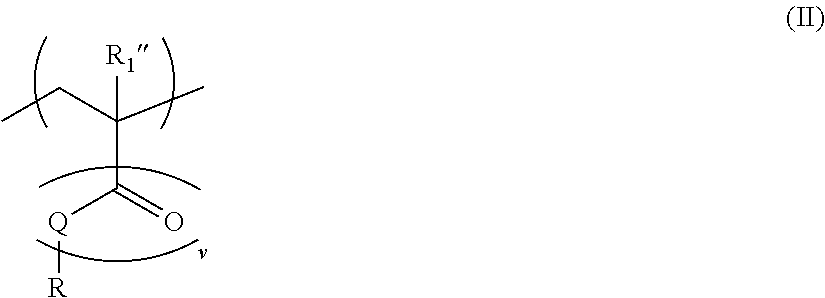Use of a particular copolymer for preventing deposits on the valves of indirect injection petrol engines
a technology of indirect injection and copolymer, which is applied in the petroleum industry, liquid carbonaceous fuels, fuel additives, etc., can solve the problems of valve sticking, negative impact on consumption and emissions of particles, and engine performance qualities
- Summary
- Abstract
- Description
- Claims
- Application Information
AI Technical Summary
Benefits of technology
Problems solved by technology
Method used
Image
Examples
examples
[0394]1. Preparation of a Copolymer According to the Invention:
[0395]A quaternized EHMA / DAMEMA diblock copolymer in accordance with the present invention was synthesized by RAFT-type radical copolymerization, in accordance with the protocol described below.
[0396]EHMA Block A:
[0397]30.01 g (0.26 mmol) of 2-ethylhexyl methacrylate (EHMA), 2.89 g (13 mmol) of 2-cyano-2-propyl benzodithioate and 35 ml of toluene are introduced into a 250 ml round-bottomed flask. 210 mg (1.29 mmol) of azobisisobutyronitrile (AIBN) are weighed out in a 20 ml round-bottomed flask and then dissolved in 4 ml of toluene. The two solutions are degassed with nitrogen for 30 minutes. The solution containing the EHMA monomer is heated to 80° C. When the temperature is reached, the AIBN solution is added using a syringe purged with nitrogen beforehand. The reaction medium is stirred at 80° C. for 24 h under an inert atmosphere (N2).
[0398]A 250 μl sample is withdrawn at t0 (immediately after addition of AIBN) and a...
PUM
| Property | Measurement | Unit |
|---|---|---|
| mol % | aaaaa | aaaaa |
| temperature | aaaaa | aaaaa |
| temperature | aaaaa | aaaaa |
Abstract
Description
Claims
Application Information
 Login to View More
Login to View More - R&D
- Intellectual Property
- Life Sciences
- Materials
- Tech Scout
- Unparalleled Data Quality
- Higher Quality Content
- 60% Fewer Hallucinations
Browse by: Latest US Patents, China's latest patents, Technical Efficacy Thesaurus, Application Domain, Technology Topic, Popular Technical Reports.
© 2025 PatSnap. All rights reserved.Legal|Privacy policy|Modern Slavery Act Transparency Statement|Sitemap|About US| Contact US: help@patsnap.com



